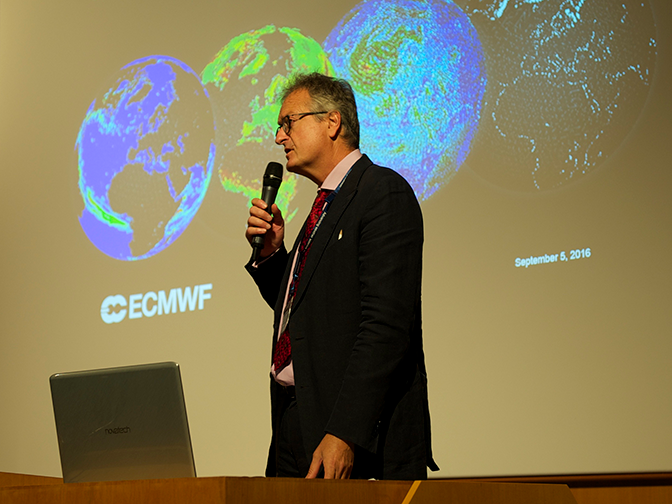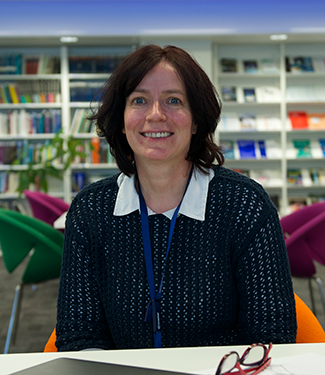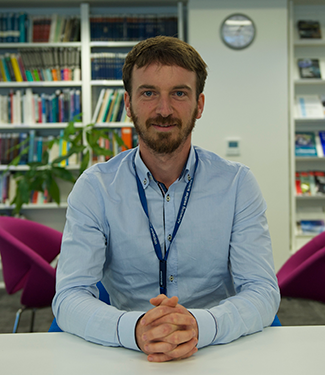

About 100 people met in Reading from 5 to 8 September for one of ECMWF’s flagship events, the four-day Annual Seminar.
The topic this year was ‘Earth system modelling for seamless prediction’, addressing the specific question of which processes we should focus on to further improve atmospheric predictive skill.
This is a key issue for many of the world's leading meteorological services.
It is being tackled by scientists working on weather prediction at a global scale, and on forecast horizons ranging from a few days to a few months.
ECMWF Director of Research Erland Källén gave an introductory talk, in which he pointed out that Earth system modelling is a key pillar in the Centre’s new ten-year Strategy.
Does predictability require complexity?
The first of the six sessions discussed the overarching theme of whether predictability requires complexity. Andy Brown (UK Met Office) challenged the audience by asking what benefits complexity really brings. He suggested that two reasons why we might need to embrace complexity are to predict new fields and variables and to extend the predictability limit.
But he also warned that we should not forget to improve basic processes such as clouds, drag and the numerics of our models, as this can still improve skill considerably – perhaps more than increasing complexity!
Evidence that complexity can improve forecast quality came from Frédéric Vitart (ECMWF), who showed that adding a dynamical ocean improved the accuracy and reliability of ECMWF’s forecasts. He also showed preliminary results illustrating that including aerosol effects could bring further improvements.
Ben Kirtman (University of Miami) discussed the link between complexity and resolution, pointing out that the need for complexity increases with increased resolution. How do we measure whether complexity delivers improvements? Not only by looking at forecast accuracy but also by considering other key properties, in particular forecast reliability.
Tim Palmer (University of Oxford) introduced the concept of 'imprecise complexity' and said information theory could help us to define which processes are important. He also stressed the crucial importance of improving reliability for both weather prediction and climate projection.
Atmospheric processes
In the session on atmospheric processes, Nils Wedi (ECMWF) stressed the need to consider numerical and structural flexibility as we move towards greater Earth system complexity.
Brian Medeiros (NCAR) reminded participants that clouds are relevant for predictions across timescales, and yet they remain crudely parametrized.
 |
“Isolating the role of stratospheric processes in predictive skill of tropospheric circulation and teleconnections is a challenge because tropospheric and stratospheric circulation are closely coupled both upward and downward with upward influence dominating. “The stratosphere provides an important pathway by which tropospheric circulation anomalies and teleconnections can be modified. "A lack of proper representation of stratospheric processes and troposphere-stratosphere coupling degrades the potential predictive skill on subseasonal to interannual timescale in the troposphere.” (Judith Perlwitz – CIRES/NOAA) |
Talking about tropical variability and its links with predictability, Steve Woolnough (University of Reading) said there was still a long way to go to understanding the initiation of the Madden Julian Oscillation, one of the key modes of tropical variability that affects European predictability. We have to make progress in this area if we want to extract further predictable signals from the tropics.
Franco Molteni (ECMWF) also stressed the role of the tropics. Discussing interactions between different scales, he said that heat fluxes at the ocean surface play an important role in establishing teleconnections, e.g. between the tropics and the extra-tropics.
The final talk in this session discussed the role of the stratosphere. Judith Perlwitz (CIRES/NOAA) said that a lack of proper representation of stratospheric processes degrades the potential predictive skill on sub-seasonal to inter-annual timescales in the troposphere.
Ocean, waves and sea ice
The third session moved the focus from the atmosphere down into the ocean. David Ferreira (University of Reading) said that although new concepts are emerging about the role of resolution in the ocean, there is still no clear evidence that adopting very high resolution leads to more skilful predictions.
Helene Hewitt (UK Met Office) was of a slightly different opinion, saying that resolution matters: tropical and boundary currents require a minimum resolution of 0.25°, but ideally at least 0.1°. She also said that in the vertical there should be enough resolution to resolve the diurnal cycle.
 |
“A large amount of data on sea-ice drift and deformation is available routinely from the analysis of high-resolution satellite SAR images. “Using data assimilation along with a sea-ice model able to reproduce the observed sea-ice drift and deformation would make it possible to improve operational forecasts in the polar regions. “Sea-ice drift and deformation also influence the evolution and location of the thicker ice and may be crucial for seasonal prediction, for example to predict accurately the minimum sea-ice extent at the end of summer." (Sylvain Bouillon, NERSC)
|
Jean Bidlot (ECMWF) discussed the importance of simulating key air–sea interaction processes. He illustrated how this is achieved at ECMWF by coupling models of the dynamical ocean, waves and sea ice. He concluded by saying that a system that is more physically based will in the long term bring more benefits.
A similar point was made by Silvain Bouillon (NERSC), who, while talking about sea ice, pointed out that if a model cannot simulate a phenomenon, it cannot predict it. He also highlighted why sea-ice modelling is a challenge and why the existing models are far from being able to simulate the key processes.
Continental surface processes
The fourth session considered the continental surfaces. Gianpaolo Balsamo (ECMWF) explained why land processes matter for many forecast timescales. Resolution and complexity are both required to improve the simulation of surface processes, he said.
Randal Koster (NASA) pointed out that there is a need for better data for initialisation, and that we should aim to develop methods that can use more of the existing observations to maximise the impact on forecast skill.
Anna Agusti-Panareda’s (ECMWF) talk on climate change concluded the session. The carbon cycle is at the heart of climate change, she said, and for weather, we should explore the use of dynamic vegetation to link water, energy and carbon.
Aerosols, greenhouse gases and chemical components
The fifth session examined the role of aerosols, greenhouse gases and chemical components. Daniel Jacob (Harvard University) reminded the audience that societal demands go beyond weather forecasting, which could be justification enough to add complexity and include atmospheric composition and chemistry in Earth system models.
Peter Colarco (NASA) strengthened this message, saying that including aerosol radiative effects has clear impacts on both weather prediction and climate simulation.
In his talk on ozone, Johannes Flemming (ECMWF) made a similar point. He said that an improved representation of ozone helped to reduce upper stratosphere biases both in ten-day forecasts and in longer, one-year integrations.
Implementation strategies
In the last session, speakers from three centres highlighted the challenges associated with producing weather forecasts using Earth system models.
 |
“We are moving towards a paradigm shift away from pure weather forecasts towards an environmental prediction framework. This will improve weather forecasts at the same time as enabling environmental predictions, for example sea-ice predictions as part of a marine service. “From an implementation point of view, it is important to get some of the small-scale details right. For example, including parametrizations for sea ice attached to the coastline has helped to better represent areas of open water surrounded by sea ice. “It is also important to minimise initialisation shocks through the careful treatment of the marine surface boundary layer.” (Gregory Smith – CCMEP)
|
Patrick Laloyaux (ECMWF) gave an overview of ECMWF’s work related to coupled modelling and assimilation. As an example of the benefit of moving towards more complex Earth system models for weather prediction and climate monitoring, he showed that coupled reanalyses are better able to reproduce the past Earth system climate.
Hendrik Tolman (US NWS) gave an overview of activities in this area at the US National Weather Service. He highlighted how challenging it is to simulate in an interactive way all key, relevant Earth system components. Coupling is not only needed on scientific grounds, he said, but it might be required from an engineering perspective if we want to provide forecasts of many aspects of the Earth system simultaneously.
Gregory Smith (CCMEP) spoke about work in this area in Canada, pointing out the key role that introducing a coupling to the ocean and sea ice had for forecasts in the region of Canada. With regard to how strong the coupling needed to be and when in the forecast range it was required, he said that coupling should be done by ‘shaking hands’ at the initial time.
"Excellent overview"
“The 22 speakers gave an excellent overview of why we have to include many processes in our models if we want to extend the forecast skill horizon of our products and provide new services to our users,” ECMWF Lead Scientist Roberto Buizza said.
“The Annual Seminar confirmed that our ten-year Strategy rightly emphasises the importance of improvements in Earth system modelling."
More information
Presentations and recordings are available on the Annual Seminar 2016 web page.
